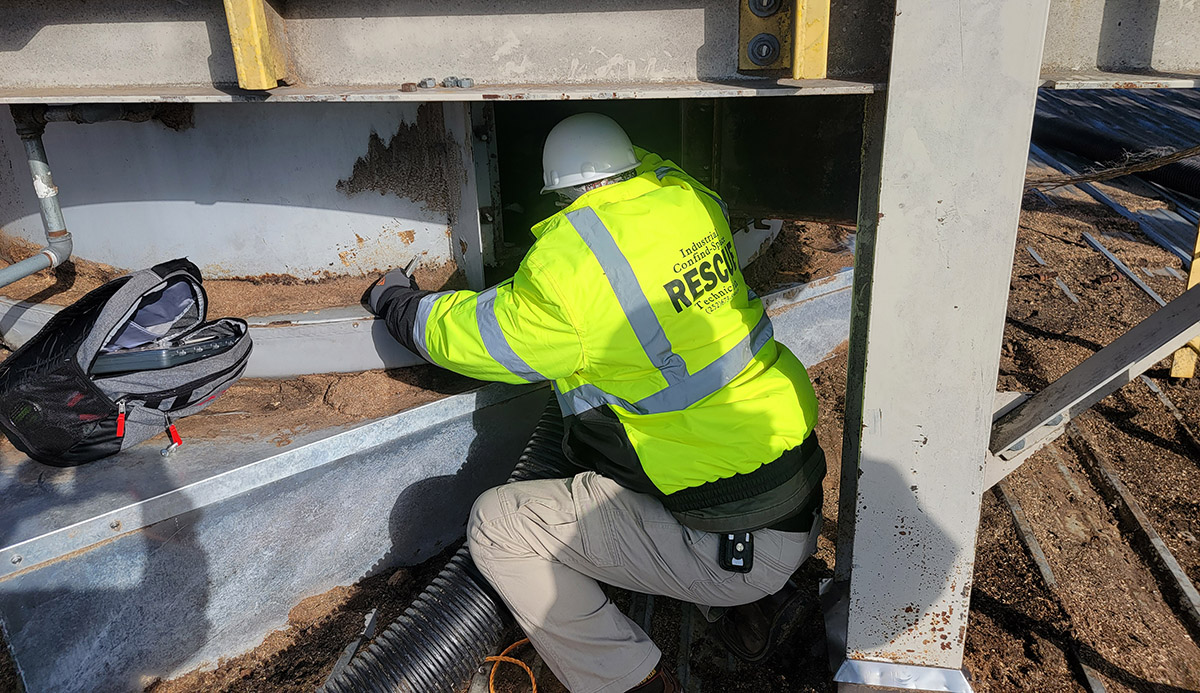Can you safely rescue someone if they are trapped in a confined space?
Confined Space Rescue Teams are an important part of the safety plan for many types of industrial and agricultural operations. Permit-required confined spaces are confined spaces that have the potential to entrap or engulf the entrant, making it difficult to safely remove them from the space should they become unconscious. In the case of a rescue, do you know how many people are needed on the rescue team and what they should be able to do?
Guidelines for confined space rescue teams, including the size needed, are provided by OSHA and the NFPA350. Rescue services personnel, whether it is a private company such as Hux Safety Solutions or another firm, need to have rescuers on staff with the appropriate PPE, rescue equipment, rescue operations training, and a rescue plan for entry.
Key items For Consideration Before Entering The Confined Space
When planning a confined space entry, here are some key things to consider before entering.
- What are the potential hazards?
- Is first aid readily available?
- What atmospheric hazards are there? Do you need a respirator?
- Have you measured for oxygen deficiency in the confined space?
- Is there a good air supply and is air monitoring needed?
- Are there flammable gasses?
- Do you have communication equipment?
- Do you have a defined rescue plan and rescue procedures in place?
How To Determine The Size Of The Team
According to the NFPA350, "Confined space rescue teams should have enough qualified members to accomplish every function required to achieve the rescue objective. The size and capability of a team will depend on many factors, including, but not limited to, the condition of the person who entered the confined space, the size and shape of the space, the size of the access opening, and the hazards present."
Specifically, the NFPA350 says, "The size of a rescue team will be determined by the size of the space and the difficulty of the rescue operation. Typically, the entry team size should be at least three members. However, some spaces requiring technician-level resources may be only large enough to accommodate a single rescuer. Some incidents may involve large spaces or complex rescue operations that require several rescuers to enter the space."
NFPA350 Confined Space Rescue Team Staffing Decision Table
When working to plan the size of your confined space rescue team we recommend the following guidelines from the NFPA350 to plan your rescue team:
- If the confined space has no obstructions or entanglement hazards and the entrant is properly attached to a retrieval system, then one rescuer is needed to perform a non-entry rescue
- If the confined space has obstructions or entanglement hazards, the entrant is not attached to a retrieval system, no potential atmospheric hazards exist, and vertical extraction is not required, then three rescuers are needed to perform an emergency entry to effect rescue. One rescue attendant, and two rescue entrants.
- If the confined space has obstructions or entanglement hazards, the entrant is not attached to a retrieval system, no potential atmospheric hazards exist, and vertical extraction is required, then five rescuers are needed to perform an emergency entry to effect rescue. One rescue attendant, two rescue system operators (with assistance from plant personnel), and two rescue entrants.
- If the confined space has obstructions or entanglement hazards, the entrant is not attached to a retrieval system, potential atmospheric hazards exist, SAR cannot be used (requiring SCBA)and vertical extraction is not required, then five rescuers are needed to perform an emergency entry to effect rescue. One rescue attendant, two person entry team, and two rescue entrants.
- If the confined space has obstructions or entanglement hazards, the entrant is not attached to a retrieval system, potential atmospheric hazards exist, (requiring SAR) and vertical extraction is not required, then six rescuers are needed to perform an emergency entry to effect rescue. One rescue attendant, two rescue entrants, 2 backup rescue entrants, and one air supply operator.
- If the confined space has obstructions or entanglement hazards, the entrant is not attached to a retrieval system, potential atmospheric hazards exist, SAR cannot be used (requiring SCBA) and vertical extraction is required, then seven rescuers are needed to perform an emergency entry to effect rescue. One rescue attendant, two rescue operators, two rescue entrants, 2 backup rescue entrants, and one air supply operator.
- If the confined space has obstructions or entanglement hazards, the entrant is not attached to a retrieval system, potential atmospheric hazards exist, (requiring SAR) and vertical extraction is required, then eight rescuers are needed to perform an emergency entry to effect rescue. One rescue attendant, two rescue system operators, two rescue entrants, 2 backup rescue entrants, and one air supply operator.
- An employee activates a fall arrest system and is suspended in a harness requiring rope rescue, then four rescuers are needed to perform a pickoff rescue. One rescue attendant, 2 rescue system operators (with assistance from plant personnel) and one rescuer.
Following these guidelines will ensure that the size of your confined space rescue team has the right number of people for the situation at hand. The number one goal is always to prevent any fatalities that could have been prevented. The NFPA350 and OSHA standards have been created to keep everyone safe in the event a confined space rescue is needed.
Contact Hux Safety Solutions today for certified & professional confined space rescue team services and find out about our unique approach to ensuring our rescue team is staffed according to standards and guidelines.

